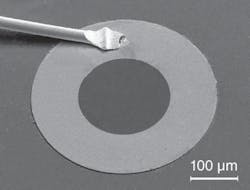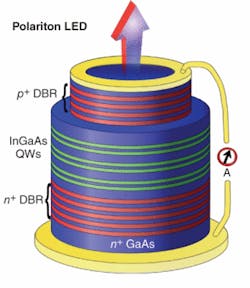Researchers at the University of Crete and the Foundation for Research and Technology-Hellas (both in Heraklion, Crete, Greece) have created an electrically pumped polariton light-emitting diode (LED), a development that helps pave the way toward light emitters having unprecedented quantum efficiency and ultralow power consumption.1
The definition of a polariton and its implications for the photonics industry is perhaps best described in a recent Nature article by Benoît Deveaud-Plédran, physics professor in the Laboratory of Quantum Electronics at Ecole Polytechnique Fédérale de Lausanne (Lausanne, Switzerland).2 “When I first encountered the idea of a polariton … its beauty stunned me,” said Deveaud-Plédran. “These mixed ‘quasi-particles’ are produced in semiconductor materials when the pairing of an electron and its phantom, a hole (this combination in itself a quasi-particle known as an exciton), couples with the photons of a light field. The result is something that is part matter, part light, and inherits qualities of both.”
Deveaud-Plédran points out that in 1991, stable-cavity polaritons—created when excitons are confined by changes in the chemical composition of a substrate to a quantum energy well with the simultaneous localization of photons in the same region using two reflective mirrors—were the first step in bringing polaritons out of the lab and into the real world.
Because polaritons have large de Broglie wavelengths of around 1 µm, they are appealing for applications in quantum optics. And, says Deveaud-Plédran, “They are good bosons, meaning that they can be parametrically amplified (that is, split up or joined together in units of different energy, a useful technique for signal amplification), and that many of them can pile up in a given quantum state, eventually leading to the formation of the state of matter known as a Bose-Einstein condensate.”
Toward room-temperature operation
Last year, a room-temperature-operation microcavity gallium nitride (GaN) polariton laser was developed by researchers at the University of Southampton (Southampton, England) and the Institute of Quantum Electronics and Photonics (Lausanne, Switzerland); the device lased at an optically pumped input-power threshold of only 1 mW—an order of magnitude lower than the best performance reported at that time for a GaN quantum-well vertical-cavity semiconductor laser (VCSEL). Now, the Cretan researchers continue the march toward real-world polariton sources with their development of a near-room-temperature electrically pumped gallium arsenide (GaAs) polariton LED.
The emission of coherent monochromatic light in a polariton laser does not rely on the classic population-inversion scheme; instead, the bosonic nature of exciton-polaritons allows them to condense in a single quantum state. To build the microcavity structure of the polariton LED, an indium gallium arsenide (InGaAs) quantum well was fabricated between two distributed-Bragg-reflector (DBR) mirrors built from layers of GaAs and aluminum arsenide (AlAs). To enable electrical injection, an n-type ohmic contact was evaporated on the back of the device and a p-type ohmic contact was deposited on top of the device (see figure). To minimize doping-related losses in the cavity, the first half-period of the DBRs was undoped. To capture the wide range of angular output from the LED, a special goniometer was built.To study the emission properties of the LED device, both temperature and angular tuning measurements were made to ensure that emission was due entirely to polariton states. Indeed, electroluminescence spectra from the LED between 180 K and 260 K show cavity-mode and exciton emissions exhibiting a characteristic so-called “anticrossing” behavior of the strong coupling regime—the first demonstration of polariton emission in an electrically pumped semiconductor microcavity. At low injection current, two clearly resolved polariton peaks can be observed. However, as injection-current density increases, a transition to the weak coupling regime occurs and standard VCSEL operation is observed.
“One of the main conclusions of this work is that by dressing excitons with photons one can suppress substantially the exciton-phonon scattering, making GaAs-based polaritonic devices feasible at room temperature,” says Professor Pavlos Savvidis, one of the researchers. “Our immediate goals are the demonstration of a room-temperature polariton emitting device and the development of an electrically pumped polariton laser, which would require added sophistication of the injection schemes that will bolster efficient condensation of polaritons inside the trap.”
REFERENCES
1. S.I. Tsintzos et al., Nature 453, 372 (May 15, 2008).
2. B. Deveaud-Plédran, Nature 453, 297 (May 15, 2008).


